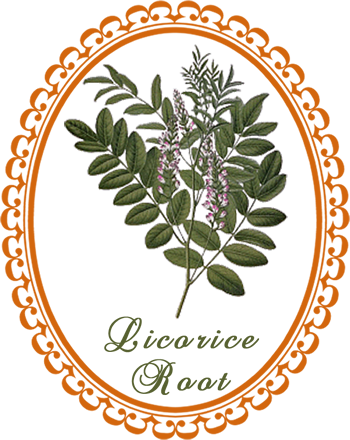
Licorice Root: helps balance and regulate all body functions and stimulates immune cells to attack invading pathogens ...
Common Names: Licorice, Sweet Root
Botanical Name: Glycyrrhiza glabra
Family: Fabaceae
Plant Type: Perennial
Parts Used: Roots
Flowering: July - September
Native to southern Europe and western and central Asia, Glycyrrhiza glabra is now cultivated in many temperate regions worldwide, including parts of North and South America and Australia.
Description: Licorice is a perennial herb that grows to three feet tall and has a woody, branching, brown rhizome (underground stem) that is yellow inside. Compound leaves are composed of three to seven pairs of small oblong leaflets, while purplish flowers bloom in terminal spikes. Fruits are smooth, reddish-brown pods.
Cultivation: Licorice is a hardy perennial, growing well in neutral pH, rich, moist soil in full sun to partial shade. Runners from old plants are planted in late fall or early spring.
Harvesting: Fertilize well and pick flowers as they grow, to improve root quality. Once the plants are three or four years old, dig up the roots in late fall and dry.
Commercial Uses: Licorice is used to help beer foam, and as a foaming agent in fire extinguishers. It is used in fertilizers, insecticides, and insulation. It is also used extensively in flavoring tobacco, with some tobacco products containing as much as 10% licorice.
Culinary Uses: Licorice is used as a flavoring for many things, including candy and liqueurs. It is used commercially in everything from pastries and ice cream to soy sauce and soy meat substitutes.
Licorice Magick
Lust. Love. Fidelity.
Gender: Feminine
Planet: Venus
Element: Water
Drink licorice root tea to increase your libido and enhance your sexual pleasure.
Add licorice to love and lust sachets, carry to attract love, and use in spells to ensure fidelity.
Herbal Healing with Licorice
Cosmetic Uses: Licorice is a soothing emollient. Use it in steam facials as it helps open the pores so other herbs can penetrate. It is also useful as a shampoo for oily hair, as it tends to suppress the scalp's production of oil.
Medicinal Actions: Anti-allergic, antibacterial, anticonvulsive, anti-inflammatory, antiphlogistic, antitussive, demulcent, diuretic, expectorant, laxative (mild), wound-healer
Medicinal Uses: Licorice reduces blood cholesterol, fevers and inflammation; promotes wound healing, increases bile secretion; decreases gastric secretion; increases blood sodium but decreases blood potassium. Licorice is widely used in cough syrups and lozenges. It is frequently used to treat ulcers, and helps in the treatment of menstrual cramps. It is also useful in treating Addison's disease. Licorice contains substances that are very similar to the body's natural steroids, and it can be used to treat conditions that respond to steroidal drugs such as arthritis, ulcerative colitis, eczema or any other condition involving inflammation.
Contraindications:
- Avoid licorice root during pregnancy.
- Licorice root should be avoided by cardiac patients.
- Avoid licorice root if you suffer from kidney disease, high blood pressure or obesity.
Body Care with Licorice Root
- To ease a sore throat, drink a wineglassful of licorice decoction three times daily, as required.
- To ease bronchial or asthmatic coughs, take 1 - 2 teaspoons licorice syrup three times daily for no more than two weeks.
Decoction: Simmer 3 teaspoons of peeled, bruised licorice root, or 3 teaspoons licorice root powder in 750 ml (3 cups) water for 10 minutes. Strain
Syrup: Add 500 ml (2 cups) honey to 500 ml (2 cups hot licorice root decoction (see above) and stir until dissolved. Cool and refrigerate - this will keep indefinitely.
Healing Combinations with Licorice Root
- For a soothing, anti-inflammatory action and to stimulate the flow of mucus from the lungs and bronchi, combine with thyme (Thymus), elecampane (Inula), and echinacea (Echinacea)
- To soothe gastritis and peptic ulcers, combine with comfrey (Symphytum), meadowsweet (Filipendula), or marshmallow (Althaea)
- For arthritis, use licorice with devil's claw (Harpagophytum), celery (Apium), and comfrey (Symphytum)
- For ulcerative colitis and Crohn's disease, combine it with Roman chamomile (Chamomilla), lemon balm (Melissa), and comfrey (Symphytum)
- For the treatment of eczema, combine licorice with red clover (Trifolium), yellow dock (Rumex), and heartsease (Viola)
If you appreciate the information provided,
please help keep this website running. Blessings!
© 2008-2025 aromaworx.ca. All rights reserved.

